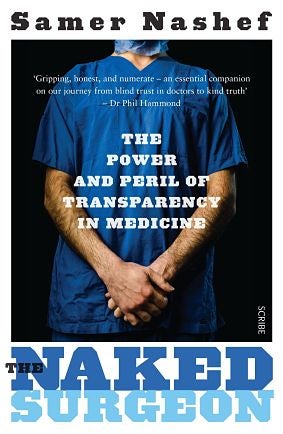The Naked Surgeon, by Samer Nashef - book review: Uncomfortable numbers on matters of life and death
Scribe - £14.99

When Samer Nashef was a student on a vascular surgical unit, he carried out a study that had never been done before in his unit. He compared the mortality rates for the operations carried out by different surgeons in the department. To his surprise, he found that the lowest mortality rates were associated with two non-vascular surgeons. When he asked his audience of vascular surgeons if they wanted to see the comparison of death rates, the atmosphere became icy. His assessment on that unit stated that he was arrogant. Nashef had learnt what happens to medics who rock the establishment boat.
But this dedicated man did not fall out of the boat, nor cool his ardour for examining surgical outcomes. He trained as a cardiac surgeon, and devised a risk-assessment system for cardiac surgery patients, EuroSCORE, that has now been adopted throughout the world.
This bold, brilliant book is Nashef’s explanation of why risk-adjusted surgical outcomes, and similar assessment in all specialities, are so important. And it details the many traps that the well-meaning can walk into when compiling or comparing data.
Nashef’s writing is lucid, free of medical jargon and, unlike many academic books, it is not dry, being strewn with anecdotes and jokes.
Up until a few decades ago, it was taboo to question the results of particular surgeons or physicians. There was little transparency in medicine, and next to no audit. Things are changing. Cardiac surgery has led the way, and there is a UK website on which people can compare the results of different cardiac surgeons. But care is required. A surgeon with better figures than another may simply be taking on lower-risk patients. Or they may be engaging in “category shift”, that is the reclassifying of high-risk patients who are likely to die into other categories of surgery by adding on unrequired procedures. And if this sounds like scare-mongering, Nashef has carried out anonymous questionnaires which have confirmed that both these things happen.
Having trained at Bristol, Nashef is in a strong position to talk about the Bristol paediatric cardiac surgery scandal, and the way it heralded a new era of clinical governance where doctors and hospital managers had to take responsibility for their own performance and that of their colleagues. Dr Steve Bolsin, a brave anaesthetist, was the man who blew the whistle on the unacceptably high incidence of deaths in Bristol, and he eventually left the UK. Medics hold grudges. But that climate is, thankfully, changing. Dr Bolsin has written a moving appendix about the tragic events in Bristol.
Nashef talks the reader through basic statistics, explaining how a finding of statistical significance is defined, how it depends on size of sample and size of measured difference. He discusses pitfalls such as basing a decision on anecdote. He describes how risk adjustment is made to ensure that results of studies are not skewed by low-risk patients being compared with high-risk ones. Interestingly, just measuring outcomes can lead to an improvement in outcomes if surgeons know they are being assessed.
The most fascinating sections are those on factors that can affect surgical outcome. Having an operation? Don’t book it for the day before your surgeon goes on holiday, because the mortality rate then is more than double that for the first day when they return. Nashef postulates reasons for this: surgeons may be at their most risk-taking when harried on the day before a holiday, and more careful and relaxed on the first day back from one. The same explanation may be responsible for the fact that the expected death of a high-risk patient is more likely to lead to increased mortality of patients operated on in the next 48 hours than the unexpected death of a low-risk patient. (The former is usually an out-of-hours nightmare which will make the surgeon fatigued, late for other ops and thus, risk taking, while the latter is a shock on an elective day list which will cause the surgeon to be extra meticulous.)
There are hair-raising sections on how despite disasters in cardiac surgery arising from surgeons handling Prolene sutures with metal instruments, or not locking knots, many surgeons continue to do this. Nashef also compares the millions spent on investigating near-misses or disasters in the aviation industry, or in the field of terrorism, with the negligible amounts spent in medicine.
There are two tiny errors. On page 31 Nashef mistakenly calls the dangerous surgeon of his example Surgeon B instead of Surgeon A. And on page 155 he says the risk- adjusted mortality rate is the ratio between actual mortality and expected mortality, though it is actually the other way around: expected to actual.
This is an essential book for anyone contemplating surgery, medical treatment, or a career in medicine.
Join our commenting forum
Join thought-provoking conversations, follow other Independent readers and see their replies
Comments